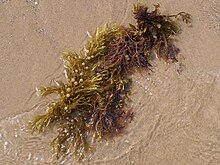Sargassum muticum
| Sargassum muticum | |
|---|---|
 |
|
| Scientific classification | |
| Domain: | Eukaryota |
| (unranked): | SAR |
| Superphylum: | Heterokonta |
| Class: | Phaeophyceae |
| Order: | Fucales |
| Family: | Sargassaceae |
| Genus: | Sargassum |
| Species: | S. muticum |
| Binomial name | |
|
Sargassum muticum (Yendo) Fensholt |
|
Sargassum muticum, commonly known as Japanese wireweed, is a large brown seaweed of the genus Sargassum. It is an invasive seaweed with high growth rate (until 10 cm per day during spring). It has an efficient dispersion thanks to its floats.
Sargassum muticum is a brown seaweed, normally brown to yellowish with a length up to 10 m. It is an autotroph that uses energy from sunlight. The photosynthesis is facilitated thanks to aerial vesicles which allows the algae to raise to the surface.
Sargassum muticum is composed of two distinct parts: a perennial part, which contains the holdfast and one or more short main axes; and an annual part: the secondary axes, which develop on the main axis, whose growth is unlimited and the size is variable. There are three types of ramifications: laterals with foliaceous expansions called fronds, laterals with fronds and aerocysts and laterals with fronds, aerocysts and reproductive organs called receptacles. In winter, only the perennial part persists (5 cm). In summer, the lateral part is in maximum development of 2–3 meters to 10 meters.
The mode of reproduction is both sexual and asexual. S. muticum reaches sexual maturity in the summer when gamete production takes place in receptacles. The species is monoecious, ie an individual is capable of producing male and female gametes. Its cycle of development is monogenic (ie only one generation is present during its life cycle). At the level of fertilization: male gametes are dispersed in seawater while female gametes remain in the receptacle where fertilization takes place). Development is also done at the receptacle and then once at the stage of seedling, the latter is detached for fixation on a new support and form a new individual. This species can also reproduce asexually. But this has never been observed in temperate environments.
Sargassum muticum grows from half-tide to infralittoral areas (to a depth of 10 m.). It is fixed on solid substrates like rocks, stones, shells. It is highly tolerant towards temperature and salinity variations. The optimal temperature is between 17 and 20 °C but it tolerates -9 and 30 °C.
Originally from Japan, it is thought to have gained worldwide distribution through being transported with Japanese oysters (Crassostrea gigas). Sargassum muticum was introduced to the Californian coast in the 40's and in Europe in the 70's (The species was first found in the British Isles in the Isle of Wight in 1973). Currently, the alga is widespreaded from Norway to Portugal along Atlantic's coasts. Sargassum muticum has a range stretching from Campbell river, British Columbia to Baja in California. In Europe it extends along the coasts of Great Britain, France, Scandinavia, Baltic Sea, Helgoland, Netherlands, Ireland, the Iberian Peninsula and into the Mediterranean from Italy and the Adriatic. It is recorded from Japan, China and Alaska. Recently, some specimens were find on Moroccan coasts. It illustrates its huge tolerance regarding to its environments. Herbarium specimens are now stored in the Ulster Museum (BEL catalogue numbers: F11241 - F11242; F11182 - F11185).
...
Wikipedia
